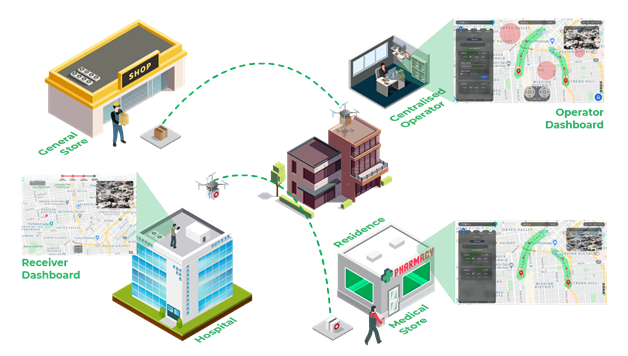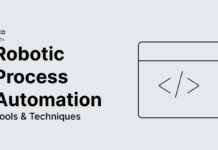Back in 2013, Amazon first announced its plans for Prime Air – a drone delivery platform to make last-mile deliveries from their fulfillment centers to their customers’ homes so as to cut the delivery time to just 30 mins. In 2016, they grabbed headlines by successfully using a drone to deliver a package to a customer’s home in Cambridge, England.
Fast forward to 2020, the COVID-19 pandemic has certainly made people realize that drones do offer an efficient alternative to the traditional door to door delivery system. Drones are fast, contactless, cost-effective, and can be deployed on request, especially during emergencies.
In a pandemic like situation, autonomous drone fleets can deliver medicines, samples, emergency aids and/or food supplies. Pandemic or not, it’s safe to say that drone delivery isn’t a luxury or a thing of the far future, rather a necessity in our immediate future.
How drones have been used for managing COVID-19 spread
In the ongoing global fight against COVID-19, China has used drones for medical sample deliveries since it reduces the number of people coming in contact with the blood samples and nasal swabs. In fact, this is one of the key measures that China has taken to protect its health workers.
Amidst the country-wide lockdown in India, various drone startups have come forward to help local authorities with their drone expertise. One such startup is Dronelab based out of Gujarat, who’s working closely with the state government to use drones for street patrols and medical deliveries. They also helped the Ahmedabad police to set up a command center using the Flytnow software to remotely and centrally monitor all the drones flying over the city.

United Parcel Service, one of the largest providers of package delivery and supply chain services, is delivering vital medical supplies to retirement centers in the US using drones, in partnership with CVS Health Corporation. US regulators have given their permission for such flights since it helps minimize human contact and save the lives of both patients and health workers.
What is the future of drone delivery?
We have seen the likes of UPS, Zipline, Wing, Antwork technologies and others make real-world commercial deliveries possible using drones. They have partnered with the likes of Starbucks, KFC, and other retailers who benefit from the formers’ operations by opening up a new channel of last-mile delivery.
Drone technology – both hardware and software – has evolved rapidly over the past few years. Today, there is a wide variety of commercially available drones that can be used for deliveries – they vary in terms of the weight of the payload, aerial distance coverage, safety mechanisms, stability in rainy/windy conditions, and the speed at which the deliveries can be made.
The coronavirus pandemic has certainly opened up avenues for testing the feasibility of drones in disaster management- thus resulting in an acceleration of innovation and a world where drone regulations are likely to become more amenable for large scale commercial adoption.
What enables drone delivery operations?

The key enabler of commercial drone delivery isn’t only suitable, cost-effective, reliable hardware but also intelligent automation software that ensures safe, timely deliveries.
Safety is of paramount importance and implementing safety measures into drones has been a challenge. These are critical to ensure the non-violation of airspace, protect the payloads, and prevent drone mishaps from harming people or property.
Drone fleet management software, such as FlytNow, offers an end-to-end solution for drone delivery operations. Using such a solution, delivery operators can plan and execute drone-based deliveries from a central dashboard, while sharing live, high-quality video and telemetry with remote stakeholders, including the end consumer.
Here are some advantages that a robust drone fleet management system provides:
- Remote connectivity: An operator can remotely manage and control a UAV fleet over 4G/5G/LTE network.
- Live drone tracking: An operator can view live locations of the drones on a map and telemetry data.
- Precision landing: Operators can precisely land a drone on a delivery location or hover the drone over a smart mailbox.
- Drone agnostic: Most such solutions support major drone hardware like DJI, PX4, or Ardupilot. A user can manage a hybrid fleet of drones as integration is available for all custom and off-the-shelf drones to begin delivery operations.
- Live video: Operators can stream live video from drones with ultra-low latency in HD quality and keep a watch of the surroundings while drones are making deliveries.
- Collision avoidance: It is the ability to sense and avoid obstacles using computer vision and intelligent algorithms.
- Geofencing: Allows drones to safely fly inside a predefined zone.
- Automated waypoints: A way to auto-generate routes from the pick-up location to the delivery location, thereby avoiding No-Fly-Zone automatically
Summary
The delivery of medicines using autonomous drone fleets gives us a glimpse of the future. Commercial drones are expected to take to the skies in millions, as they become safer, faster, cost-effective, and reliable.
The current pandemic will play a significant role in accelerating the adoption, and regulatory support, of drones – not only for medical deliveries but also for other use cases. Drone service providers, operators, system integrators, software vendors, and hardware OEMs – all continue to play an active role to ensure that drones fly while respecting privacy, security, and airspace availability.








